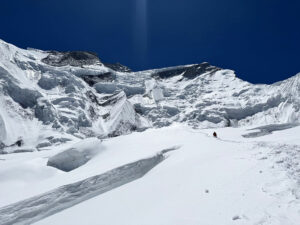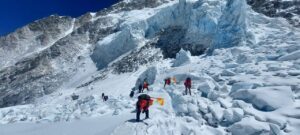The strategy followed on Annapurna some weeks ago, using helicopters to deliver ropes to higher camps, will also be decisive on Everest.
Kami Rita Sherpa and a 12-man Sherpa team left Base Camp today to fix ropes from Camp 4 to the summit of Everest. However, they will not need to carry these ropes through the treacherous Khumbu Icefall. Seven Summit Treks’ CEO Mingma Sherpa told The Himalayan Times that a helicopter has already deposited the ropes at Camp 2.

Camp 2 at Everest’s Western Cwm. Photo: Madison Mountaineering
We don’t know whether anyone has done this previously, but this time, at least, it is in the open. And so is the debate.
Fair play?
On the one hand, the rope fixers are employees working on the mountain, so why not? It allows them to travel safely and swiftly through the hazardous Icefall. It shouldn’t affect Kami Rita’s goal to break his own record and summit Everest for the 25th time. He is still climbing the entire way. He is just traveling lighter until Camp 2.
On the other hand, the move supports those voices criticizing the overuse of helicopters at Everest, including clients’ potential taxi rides above Base Camp.
Clearly, such tactics are here to stay, since they both increase the safety of Sherpas and save money (in porters’ wages) and time. Time is especially precious this season since Nepal’s COVID spike has pressured outfitters and authorities to close the season prematurely. Their only chance is to launch a summit push ASAP, touch the top, and (literally) fly out of Base Camp before they are forced out.
Expedition outfitters, also pressured not to disclose anything but wonderful news, barely update on the state of their teams’ rotations. “The weather looks pretty good –- a little snow in the forecast but not much wind,” Garrett Madison wrote yesterday.
“That bodes well for perhaps an earlier summit than normal, maybe mid-May if we’re lucky.”
The Annapurna experience
On Annapurna some weeks ago, outfitters used a similar helicopter-based strategy. On that occasion, however, rather than a planned tactic, the helicopter solved a serious miscalculation about the amount of rope needed. The improvised idea worked: The day after the rope (and oxygen) drop, everyone stuck at 7,400m proceeded to the summit. A record number of 68 people topped out that day.
Both outfitters and climbers consider that expedition a resounding success, but the climbing community was less fulsome in its praise. Should these summits be asterisked as helicopter-supported? If not for the fresh bottles of oxygen hauled virtually to the door of their tents, the many climbers dining on supplementary O2 could not have endured Camp 4 for three days.
Update on the no-O2 climbers
On Everest, there is particular interest in the handful of climbers intending to climb without oxygen. However, they have remained as discreet as the rest. Csaba Varga set off from Base Camp today on his second rotation. He intends to spend two nights at Camp 3, then touch Camp 4 at the South Col before returning to Base Camp. At this point, he will be fully acclimatized and ready to summit. Arjun Vajpai and Colin O’Brady have completed a rotation to Camp 2.

A night under the stars for Alex Txikon, with views of Everest-Lhotse and the lights of Base Camp far below. Photo: Alex Txikon
Kilian Jornet and David Göttler have not updated recently and may keep quiet until they complete whatever route they have in mind.
Finally, Alex Txikon has decided to acclimatize far from Everest and its bustling but roped-off and socially distanced Base Camp. Currently, he is on Pumori. The Spaniard spent one night at 5,800m and reached 6,200m the following morning.






